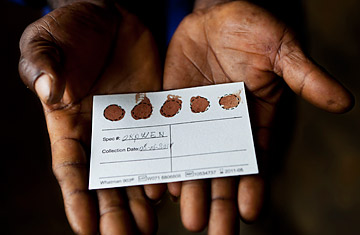
Hunters collect blood from animals they've killed and turn it in for research.
(2 of 6)
Wolfe is not alone in trying to prevent that from happening. The experience of SARS--which in 2003 moved from bats to civets before infecting humans--and the threat of avian flu sent jolts though the public-health field. The World Health Organization and the U.S. Centers for Disease Control and Prevention (CDC) have upped surveillance for new diseases, while the U.S. Agency for International Development, which disburses foreign assistance, has launched an innovative program to help beef up infectious-disease surveillance. And groups like Wolfe's GVF are bringing the concepts of intelligence gathering to epidemiology, sifting through viral chatter to detect what new biothreat might be brewing. "Virus hunters like Nathan are our first line of protection," says Dr. Larry Brilliant, the president of the Skoll Global Threats Fund and an infectious-disease veteran. "He can make a huge difference."
Where Pandemics Are Born
You think you know the story of HIV. AIDS first appeared in the U.S. in 1981, and HIV, the virus that causes AIDS, was identified in 1983. In just a few decades, HIV has become a global killer, on par with smallpox and bubonic plague, with millions infected each year. Though antiviral drugs have reduced the toll, there is no vaccine.
Wolfe tells a different tale: HIV was active among people in Central Africa for decades before it spread to the rest of the world, aided by air travel, changing sexual mores and the mass distribution of cheap syringes. The best guess is that the virus jumped from primates to humans more than a century ago, when some unlucky hunter killed and butchered a chimp infected with simian immunodeficiency virus (SIV), the primate version of HIV.
But it goes back even further. SIV has long been common in many African monkeys, in which it appears to do little harm. When viruses remain in one population for a long time, they can attenuate and lose their virulence--but viruses that jump to a new species are often extremely deadly because the new host's immune system has no means of defense. Wolfe imagines a possible Patient Zero chimpanzee millions of years ago that might have acquired different SIV strains while hunting monkeys in Central Africa. "If you look at the chimp virus that led to HIV, it's a mix of two monkey viruses," says Wolfe.
There are a few lessons here for Wolfe's work. One is that while human beings love to think our species is special, to microbes there's not much difference between a Pan troglodytes, or common chimp, and a Homo sapiens. To viruses, we all look the same--which is one reason nearly 20% of all major infectious diseases in humans began in primates, even though primates make up just 0.5% of all vertebrate species. Another point is that viruses make that leap between species when bodily fluids are shared--as tends to happen when one animal hunts, kills and eats another. Hunting and butchering, writes Wolfe in his new book, The Viral Storm, "provide superhighways connecting a hunting species directly with the microbes in every tissue of their prey."
